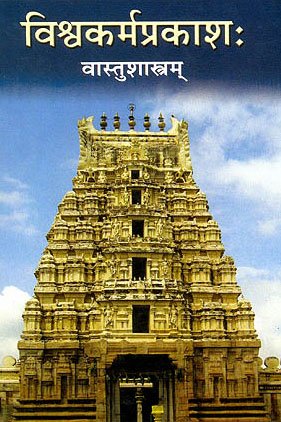Pratibandha, Prati-bandha, Pratibamdha: 16 definitions
Introduction:
Pratibandha means something in Hinduism, Sanskrit, Marathi. If you want to know the exact meaning, history, etymology or English translation of this term then check out the descriptions on this page. Add your comment or reference to a book if you want to contribute to this summary article.
In Hinduism
Shilpashastra (iconography)
Source: Wisdom Library: Śilpa-śāstraPratibandha (पादबन्ध) refers to a variety of adhiṣṭhāna, which is a pedestal or base of a structure, and a very important component in the art of construction (śilpa). Pratibandha is mentioned in the Kāśyapaśilpa as having a further 10 sub-varieties. It is also mentioned in the Pādmasaṃhita.
The following are the 10 sub-varieties of pratibandha according to the Kāśyapaśilpa:
- pratimukha,
- śrībandha,
- mañcabandha,
- abjabandha,
- śrīkānta,
- karīrabandha,
- kalaśabandha,
- śrīkara,
- śrīsaundarya,
- skandakānta.

Shilpashastra (शिल्पशास्त्र, śilpaśāstra) represents the ancient Indian science (shastra) of creative arts (shilpa) such as sculpture, iconography and painting. Closely related to Vastushastra (architecture), they often share the same literature.
Vastushastra (architecture)
Source: Shodhganga: Temples of Salem region Up to 1336 ADPratibandha (प्रतिबन्ध).—A type of adhiṣṭhāna (‘pedestal’);—Mayamata (verse 14.36) and Kāśyapaśilpa (verses 6.30-32) mention pratibandha-adhiṣṭhāna. Mayamata states “when the prativājana takes four parts and prati takes three parts then the base is called pratibandha, all the other members being same as in the kapotabandha-adhiṣṭhāna. That means to say the prati moulding which used to be the thinnest moulding in all the plinths becomes prominent and thick in this plinth. Kāśyapaśilpa (verse 6.26) states that pratibandha should possess vṛttakumuda.
However, Īśānaśivagurudeva Paddati gives a different picture of the nature of pratibandha-adhiṣṭhāna. According to this, “the upper part of the prati should be broad (pratimukha). On this, makara, mṛga, vyāla and gaja should be carved”. No mention of kapota is seen in Īśānaśivagurudeva for the pratibandha-adhiṣṭhāna .
Source: OpenEdition books: Architectural terms contained in Ajitāgama and RauravāgamaPratibandha (प्रतिबन्ध) refers to “n. of a type of base § 3.15.”.—(For paragraphs cf. Les enseignements architecturaux de l'Ajitāgama et du Rauravāgama by Bruno Dagens)

Vastushastra (वास्तुशास्त्र, vāstuśāstra) refers to the ancient Indian science (shastra) of architecture (vastu), dealing with topics such architecture, sculpture, town-building, fort building and various other constructions. Vastu also deals with the philosophy of the architectural relation with the cosmic universe.
Jyotisha (astronomy and astrology)
Source: Google Books: Studies in the History of the Exact Sciences (Astronomy)Pratibandha (प्रतिबन्ध) or Pratibandhaka refers to a “blockade” (in a hole of a bowl).—(Cf. Astronomical instruments in Bhāskarācārya’s Siddhāntaśiromaṇi).—According to Munīśvara (1603 A.D.) in his Marīci commentary on Bhāskara II: “The bowl should be so made that it has a large hole (pṛthu-chidra = mahārandhra) at the bottom. Through this statement it is indicated that the hole should be made in such a manner that, when the bowl is placed on the water of the basin and when water enters [the bowl], the hole is not blocked [i.e., pratibandhaka] by any dirt that may be in the water of the basin. Because of the possibiliy of a small hole [i.e., tat-pratibandha-sambhava] getting blocked by dirt an the like, assuming here a coalescene of the vowel a (akāra-praśleṣa) [by reading apṛthu] is not proper”.

Jyotisha (ज्योतिष, jyotiṣa or jyotish) refers to ‘astronomy’ or “Vedic astrology” and represents the fifth of the six Vedangas (additional sciences to be studied along with the Vedas). Jyotisha concerns itself with the study and prediction of the movements of celestial bodies, in order to calculate the auspicious time for rituals and ceremonies.
Languages of India and abroad
Marathi-English dictionary
Source: DDSA: The Molesworth Marathi and English Dictionarypratibandha (प्रतिबंध).—m (S) pop. pratibandī f An obstacle, obstruction, impediment. 2 The state of being stopped, hindered, detained, confined &c.
Source: DDSA: The Aryabhusan school dictionary, Marathi-Englishpratibandha (प्रतिबंध).—m pratibandī f An obstacle, impedi- ment. The state of being stopped, hindered.
Marathi is an Indo-European language having over 70 million native speakers people in (predominantly) Maharashtra India. Marathi, like many other Indo-Aryan languages, evolved from early forms of Prakrit, which itself is a subset of Sanskrit, one of the most ancient languages of the world.
Sanskrit dictionary
Source: DDSA: The practical Sanskrit-English dictionaryPratibandha (प्रतिबन्ध).—
1) Binding or tying to.
2) Obstruction, impediment, obstacle; स तपःप्रतिबन्धमन्युना (sa tapaḥpratibandhamanyunā) R.8.8; Mv. 5.4; सिद्धीनामसाधनमनवतारणमप्रवेशनं वा प्रतिबन्धः (siddhīnāmasādhanamanavatāraṇamapraveśanaṃ vā pratibandhaḥ), also प्रतिबन्धः प्रयोगो (pratibandhaḥ prayogo) ...... कोशक्षयः (kośakṣayaḥ) Kau. A.2.7.26.
3) Opposition, resistance.
4) Investment, blockade, siege.
5) Connection.
6) Cessation.
7) Disappointment.
8) (Inphil.) Invariable and inseparable connection.
Derivable forms: pratibandhaḥ (प्रतिबन्धः).
Source: Cologne Digital Sanskrit Dictionaries: Shabda-Sagara Sanskrit-English DictionaryPratibandha (प्रतिबन्ध).—m.
(-ndhaḥ) 1. Obstacle, impediment. 2. Disappointment. 3. Resistance, opposition. 4. Blockade, siege. 5. Inseparable connection. E. prati against, bandha a binding.
Source: Cologne Digital Sanskrit Dictionaries: Benfey Sanskrit-English DictionaryPratibandha (प्रतिबन्ध).—[prati-bandh + a], m. 1. Obstacle, [Mālavikāgnimitra, (ed. Tullberg.)] 10, [distich] 9; [Śākuntala, (ed. Böhtlingk.)] 23, 13. 2. Blocking up, [Harivaṃśa, (ed. Calc.)] 5512. 3. Connection.
Source: Cologne Digital Sanskrit Dictionaries: Cappeller Sanskrit-English DictionaryPratibandha (प्रतिबन्ध).—[masculine] binding to, connection, conjunction; obstruction, hindrance, resistance.
Source: Cologne Digital Sanskrit Dictionaries: Monier-Williams Sanskrit-English Dictionary1) Pratibandha (प्रतिबन्ध):—[=prati-bandha] [from prati-bandh] m. connection, uninterruptedness, [Kapila; Kāśikā-vṛtti]
2) [v.s. ...] a prop, support, [Kādambarī]
3) [v.s. ...] investment, siege, [Harivaṃśa]
4) [v.s. ...] obstacle, hindrance, impediment, [Kālidāsa; Śaṃkarācārya]
5) [v.s. ...] opposition, resistance, [Śakuntalā] (ena, by all kinds of res°, [Nalopākhyāna])
6) [v.s. ...] a logical impediment, obstructive argument, [Sarvadarśana-saṃgraha]
7) [v.s. ...] stoppage, suspension, cessation, [Pāṇini 3-3, 51] (cf. varṣapr), [; vii, 1, 45]
Source: Cologne Digital Sanskrit Dictionaries: Yates Sanskrit-English DictionaryPratibandha (प्रतिबन्ध):—[prati-bandha] (ndhaḥ) 1. m. Obstacle, disappointment; connection.
Source: DDSA: Paia-sadda-mahannavo; a comprehensive Prakrit Hindi dictionary (S)Pratibandha (प्रतिबन्ध) in the Sanskrit language is related to the Prakrit word: Paḍibaṃdha.
[Sanskrit to German]
Sanskrit, also spelled संस्कृतम् (saṃskṛtam), is an ancient language of India commonly seen as the grandmother of the Indo-European language family (even English!). Closely allied with Prakrit and Pali, Sanskrit is more exhaustive in both grammar and terms and has the most extensive collection of literature in the world, greatly surpassing its sister-languages Greek and Latin.
Kannada-English dictionary
Source: Alar: Kannada-English corpusPratibaṃdha (ಪ್ರತಿಬಂಧ):—
1) [noun] = ಪ್ರತಿಬಂಧಕ [pratibamdhaka]2 - 2.
2) [noun] a being tied, fastened, fixed or moored (to something); a coming into or being in contact (with something).
Kannada is a Dravidian language (as opposed to the Indo-European language family) mainly spoken in the southwestern region of India.
See also (Relevant definitions)
Partial matches: Prati, Bandha.
Starts with: Pratibamdhakajne, Pratibamdhapadisu, Pratibandhaka, Pratibandhakarin, Pratibandhamukta, Pratibandhana, Pratibandhatmaka, Pratibandhatmaka-vakyamsha, Pratibandhavant, Pratibandhavat.
Ends with: Apratibandha, Nitpratibandha, Samyoga-pratibandha, Sapratibandha, Sthirapratibandha, Supratibandha, Taralapratibandha, Vakapratibandha, Varshapratibandha, Vipratibandha.
Full-text (+15): Pratibandhakarin, Pratibandhaka, Padibamdha, Apratibandha, Pratibandhavant, Varshapratibandha, Sthirapratibandha, Pratibandhamukta, Pratibandhavat, Piratipantam, Patipantam, Pratibamdha, Nitpratibandha, Pratibandi, Pratibandh, Apratibandhaka, Parihapana, Taralapratibandha, Skandakanta, Pratibandhin.
Relevant text
Search found 15 books and stories containing Pratibandha, Prati-bandha, Pratibamdha, Pratibaṃdha; (plurals include: Pratibandhas, bandhas, Pratibamdhas, Pratibaṃdhas). You can also click to the full overview containing English textual excerpts. Below are direct links for the most relevant articles:
Reverberations of Dharmakirti’s Philosophy (by Birgit Kellner)
Reinterpretation of the Compound svabhāva-pratibandha
Maṇḍana Miśra’s Excursus on the Buddha’s Omniscience
Jivanandana of Anandaraya Makhin (Study) (by G. D. Jayalakshmi)
Analysis of Vyākṣepa < [Chapter 6 - Dramatic aspects of the Jīvanandana Nāṭaka]
Vakyapadiya of Bhartrihari (by K. A. Subramania Iyer)
Verse 1.3 < [Book 1 - Brahma-kāṇḍa (or Āgama-samuccaya)]
Verse 3.9.56 < [Book 3 - Pada-kāṇḍa (9): Kāla-samuddeśa (On Time)]
Verse 1.48 < [Book 1 - Brahma-kāṇḍa (or Āgama-samuccaya)]
Nyayakusumanjali of Udayana (study) (by Sri Ramen Bhadra)
Absence as a cause < [Chapter 2 - The first and second Stavakas]
A History of Indian Philosophy Volume 4 (by Surendranath Dasgupta)
Part 5 - Concept of bhakti < [Chapter XXXI - The Philosophy of Vallabha]
Part 3 - Svataḥ-prāmāṇya (self-validity of knowledge) < [Chapter XXVII - A General Review of the Philosophy of Madhva]
Part 7 - The theory of Avidyā refuted < [Chapter XXIX-XXX - Controversy Between the Dualists and the Monists]
Concept of Time in Sanskrit Grammar-Part I < [January – March, 1978]